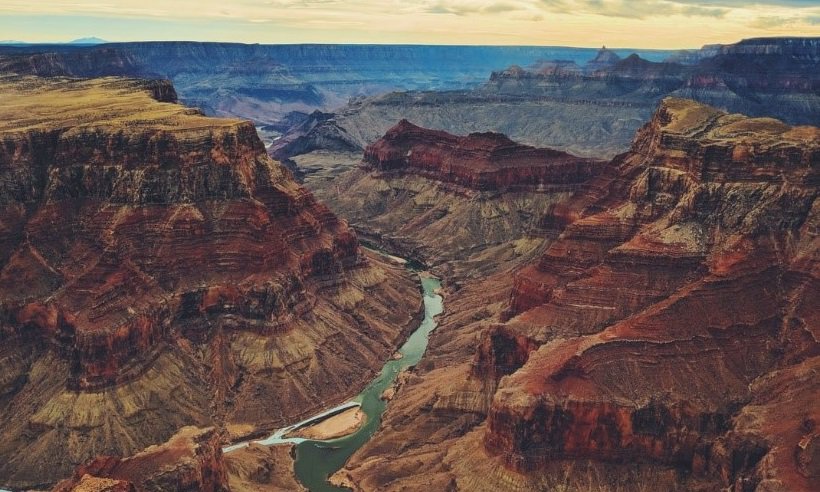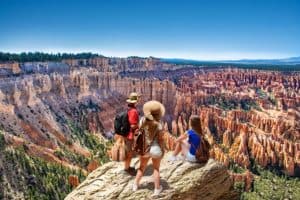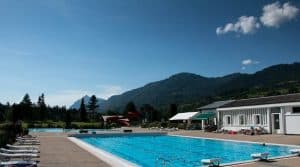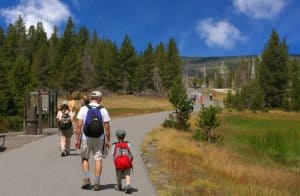Last Updated on October 10, 2024 by Alice Benny
Grand Canyon Hiking – The Grand Canyon National Park is vast and offers so much to see. However, even with several visits, you cannot see everything. The best way to make the most of your visit is to plan your Hiking the Grand Canyon itinerary carefully.
Hiking Grand Canyon
The Grand Canyon is a place of stunning natural beauty — but we’re talking about more than just that. It’s also a place where humans have long left their mark. The Grand Canyon boasts some of the oldest rock formations in the world; some dating back billions of years when prehistoric creatures roamed what would become North America. Along the path to the river itself, the park holds fossils and other remains of ancient life.
In particular, a concentration of dinosaur bones has been found along the inner edge of the Colorado River on the North Rim — a discovery that helped change our understanding of these once-mighty reptiles. And then there are the human artifacts: tepees, shelters, arrowheads, jewelry and tools. All of them offer insights into the lives of those who lived here thousands of years ago .
There are a few different ways to hike the Grand Canyon. One way is to hike from the South Rim to the North Rim Grand Canyon, which takes about two weeks. The other way is to hike from one rim to the other on a shorter time frame. If you want a more challenging hike, try hiking from one rim of the canyon to the other.
Below is a look at the top 4 Grand Canyon Hiking Trails to help you explore as much of the desert as you have time for.
Best 3-Day Hiking Tour: North Kaibab Trail Tour
- Difficulty level: Strenuous
- Hiking Level – Advanced
- Trail type: Out and Back
- Length: 28 miles (round trip)
- Elevation gain: 5,780 feet
- Average time to complete the hike: 3 days
Recommended Route for a 3-day North Kaibab Trail Tour
- Day 1: North Kaibab Trailhead – Sunapai Tunnel – Roaring Springs – Manzanita Rest Area – Cotton Campground (7 miles)
- Day 2: Cotton Campground – Ribbon Falls – Phantom Ranch –Colorado River – Bright Angel Campground (7 miles)
- Day 3: Bright Angel Campground – Colorado River – Phantom Ranch – Ribbon Falls – Manzanita Rest Area – Roaring Springs –Sunapei Tunnel – North Kaibab Trailhead (14 miles).
The North Kaibab Trail is one of the most challenging hiking tours at the Grand Canyon National Park. It is best done as a 3 days trip. However, it takes you through all the ecosystems at the Grand Canyon, including wildflowers, fir trees, aspen, limestone cliffs, riparian land, and desert vegetation. It offers great views throughout.
It is one of the best-maintained trails in the park. Although it is easy to follow, it IS quite challenging and requires advanced-level hiking and backpacking skills. The trail terrain consists of switchbacks, steep ascends and descends, tunnels, gorges, and narrow canyons.
Being an extreme hike, you need to pack adequately to ensure you have all essentials, even in emergencies. The desert climate can become too hot, especially in low elevation areas.
Therefore, it is best to start your trip by sunrise each day to ensure you have covered most distance for the day by noon. Then you can resume the hike briefly later in the afternoon when it is not too hot.
Best 2-Day Hiking Tour: South Kaibab Trail
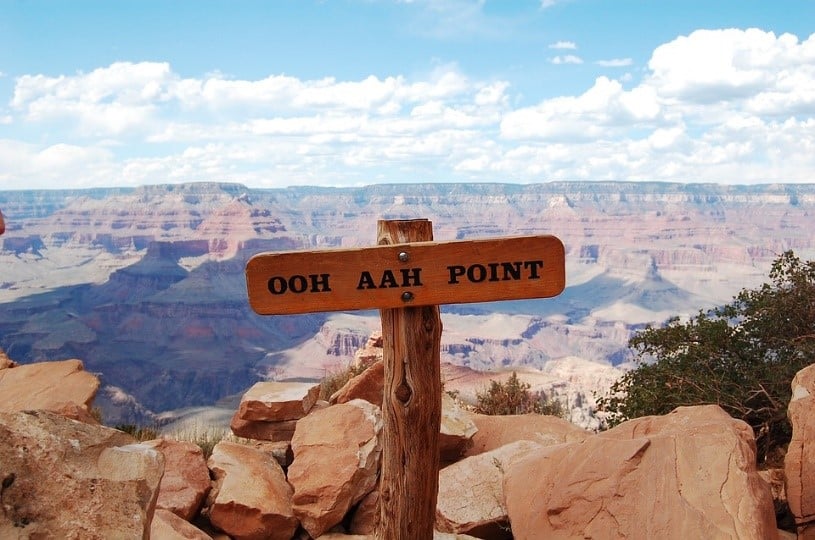
- Difficulty level: Moderate to Difficult
- Hiking Level – Intermediate to Advanced
- Trail type: Out and Back
- Length: 15 miles (round trip)
- Elevation gain: 3000 feet
- Average time to complete the hike: 2 days
South Kaibab Route for 2-Day Hike
- Day 1: South Kaibab Trailhead – Ooh Aah Point –Cedar Mesa –Cedar Ridge – Skeleton Point – Tip Off – Kaibab Suspension Bridge – Bright Angel Trail – Phantom Ranch
- Day 2: Head back
Hiking the South Kaibab Trail allows you to explore the South Rim extensively during this Grand Canyon tour. The trail is well defined and maintained, making it easy to follow. It offers an expansive view of the South Rim throughout your hike. There is no shade or water along the trail, and most of the trail is on the ridgeline.
Generally, the out route to the Colorado River is manageable as it is mostly a descent. However, coming back is quite challenging as the trail ascends consistently back to the South Kaibab Trailhead.
As such, most people opt to make this a 2-day hiking trip to allow them to rest so that they have ample time and energy to climb up the trail on the second day. There is no campground available on this trail.
However, you can easily access the Phantom Ranch campground on the North Rim. Once at the South Kaibab Trail end, cross over the Colorado River and head to the Phantom Ranch Campground for about a mile. Note that you need to book the campsite in advance.
The trail is also used by mules. When you encounter them, give way by stepping aside on the uphill edge of the trail. Listen for any instructions by the wrangler. Remain silent and still until the mules pass. Only return to the trail when the last mule is at least 50 feet past you.
Best Half-Day Hiking Tour: Grandview Trail to Horseshoe Mesa
- Difficulty level: Difficult
- Hiking Level – Intermediate to Advanced
- Trail type: Out and Back
- Length: 6 miles (round trip)
- Elevation gain: 4000 feet
- Average time to complete the hike: Half-day
Route: Grandview Trail to and fro.
The Grandview Trail is in the South Rim. It takes you to the Horseshoe Mesa copper mine. A section of the trail was handcrafted by a miner known as Pete Barry in the 1800s and consists of hand-cobbled stones.
The trail is mostly narrow and offers a spectacular view of the Canyon. It begins with steep ascending switchbacks that can be scary and difficult for people who fear heights.
This section is then followed by a section of steep descending switchbacks down the Canyon walls. It continues to descend further into geological layers leading up to the Horseshoe Mesa.
The Horseshoe Mesa extends out into a large part of the Canyon. If you head out further towards the edge of the Mesa, you will find the copper mine and cabin ruins. You also get a great view of the Tonto Plateau from the edge of Mesa.
Going back to the Grandview Trailhead is the most challenging part of the tour. Most of the hike involves going up steep switchbacks. The trail is exposed, and the temperatures are much higher in the low elevation areas near Mesa.
It is best to start the hike early in the morning to be back by noon when it gets extremely hot in the desert. There is no water anywhere along the trail so ensure to pack up more than you need and some high-energy foods.
Best Beginner-Friendly Hiking the Grand Canyon: Grand Canyon Rim Trail to Hopi Point
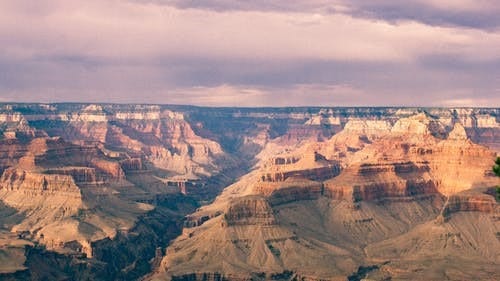
- Difficulty level: Easy to Moderate
- Hiking Level – Beginner
- Trail type: Out and Back
- Length: 4.5 miles (round trip)
- Elevation gain: 203 feet
- Average time to complete the hike: Half-day
Half-Day Route to Hopi Point Via the Rim Trail
Rim Trailhead – South Rim Trail – Bright Angel Trail – Powel Point – Hop Point, then head back
This is one of the easiest half-day hiking tours in the Grand Canyon. The trail is located in the South Rim. It is mostly flat with slight elevation in some sections. Most parts of the trail are paved, making it easy to follow.
Also, some sections are lined with pines, which provide some shade and respite from the hot sun. Several designated viewpoints along the trail include the Maricopa Point, Powell Point, and then Hopi Point. The Hopi Point offers a great view of the West Rim, and you can also see the Colorado River.
North Rim Grand Canyon Lodge Via the Transept Trail
- Difficulty level: Easy to Moderate
- Hiking Level – Beginner
- Trail type: Out and Back
- Length: 3 miles (round trip)
- Elevation gain: 282 feet
- Average time to complete the hike: Half-day
The Grand Canyon Lodge Via the Transept Trail offers a beginner-friendly, half-day trip in the North Rim. It is usually open between mid-May and mid-October. It takes you directly to the popular Grand Canyon Lodge at the edge of the Canyon. The trail route alternates between woodlands and Cliffside views and offers a great view of the North Rim.
Rim to Rim Grand Canyon
For the hearty souls who are willing to work for it – less than 1% of the Grand Canyon’s five million annual visitors – the real magic lies below the rim. On this epic Grand Canyon hike, you’ll leave from the North Kaibab Trail on the North Rim, challenging your personal limits as you descend 14.3 miles and 6,000 feet to the bottom of the canyon before connecting with the Bright Angel Trail and climbing 4,500 feet and 9.6 miles back out again to the South Rim.
Bright Angel Trail
Bright Angel Trail is a hiking trail in the Grand Canyon National Park. It starts at the North Rim and ends at the South Rim, and is roughly 10 miles long. The trail is fairly easy and has many viewpoints along the way.
Grand Canyon Arizona Trail
The Grand Canyon Arizona Trail is a hiking trail that spans the length of the state, from the California border to the New Mexico border. The trail crosses many different ecosystems and offers scenic views of lakes, rivers, mountains, forests, and desert. The trail is typically completed in sections over time.
Grand Canyon North Rim & Grand Canyon East Rim
The north rim trail runs along the rugged top of the canyon, offering sweeping views and incredible trails like the Inner Gorge Trail, which travels through narrow slot canyons.
Hiking the Grand Canyon
You can explore the Grand Canyon in various ways, including one-hour hikes, half-day hikes, full-day hikes, and multi-day hikes. It all depends on your hiking fitness level and the amount of time you have available. Most multi-day tours are difficult and require advanced hiking skills. There is a wide range of trails to choose from for full-day, half-day, and even a few hours for different levels.
Best time to visit Grand Canyon is in the off season. The peak tourist season is in summer. Most hiking trails are open all year round. However, the temperatures in summer can be too high, while in winter, there might be snow, especially in the North Rim.
Olympic National Park Hikes
Things to Do in Bryce Canyon
Zion National Park Camping | Camping in Zion
Best Time to Visit Zion National Park
Glacier National Park Camping
Best Time to Visit Joshua Tree National Park
Best Time to Visit Death Valley
Yosemite Hiking Trails
Yellowstone Hiking Trails
Things to Do in Rocky Mountain National Park
Best Time to Visit Yellowstone
Best Time to Visit Yosemite
National Parks in the USA That Should Be On Your Travel List
Saguaro National Park Tucson Arizona
